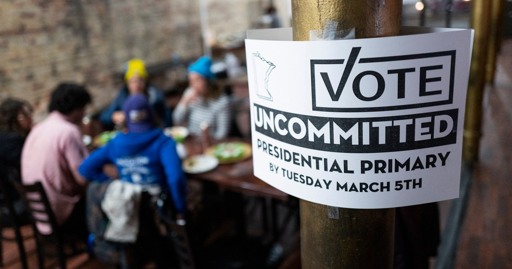

I have an admittedly archaic definition of “coverage”: reporting via the written word.
here’s an interview with her, from last year in Current Affairs: Kat Abughazaleh on How Right-Wing Propaganda Works
Kat Abughazaleh has watched a lot of Fox News. As an analyst for Media Matters, her job was to monitor the Fox primetime shows, producing videos documenting some of the most deranged stories to appear on the network. Somebody has to keep track of what’s going on in the right’s media ecosystem, and we’re glad that Kat performs this valuable public service.
Examples of her work include videos about Mike Huckabee’s indoctrination program, the “right-wing Amazon”, Tucker Carlson’s post-Fox career, Conservapedia, and her weekly Fox roundups. We can laugh at the right’s media, but its effects are alarming. Introducing Fox News to a market turns people more conservative and many people have disturbing stories of how their relatives have had their minds poisoned by the stream of hatred and paranoia that Fox transmits into their brains.
the right-wing media ecosystem she covers is inherently video-based. Fox News has text articles on their website but they probably get next to nothing in views compared to video clips on their website or their actual TV news shows.
and so media criticism of that right-wing ecosystem is also going to be inherently video-heavy. maybe you could have a text article interspersed with video clips, but that’s pretty unwieldy.
I honestly had no idea there were people doing serious reporting on there.
I’m also “old man yells at cloud” about TikTok…but you probably remember the original, early-2000s Daily Show with Jon Stewart, right? how they’d show video clips of a politician saying something, and 5 years earlier saying the opposite, etc? and how, for its time, that was a breath of fresh air? that wasn’t text-based, but it was still “serious reporting”, right? journalism is speaking truth to power. you can do that in any medium.
I’m not on TikTok, but I’ve seen enough clips shared on other platforms to know that TikTok has everything. if there wasn’t someone doing left-leaning journalism on TikTok, someone would step in to fill the void.
and it’s not necessarily all shortform video - here’s an hour-long video on her YouTube channel: The Dangerous Reality of White Christian Nationalism
but for better or worse, shortform video seems to be what gets actually watched. the video above has 82k views. meanwhile, 4 minutes on Why Conservatives Hate Being Called “Weird” has 116k (and that’s just YouTube, I suspect Instagram and TikTok views of the shorter videos are significantly higher)




















short answer: no, not really
long answer, here’s an analogy that might help:
you go to
https://yourbank.com/and log in with your username and password. you click the button to go to Online Bill Pay, and tell it to send ACME Plumbing $150 because they just fixed a leak under your sink.when you press “Send”, your browser does something like send a POST request to
https://yourbank.com/send-bill-paymentwith a JSON blob like{"account_id": 1234567890, "recipient": "ACME Plumbing", "amount": 150.0}(this is heavily oversimplified, no actual online bank would work like this, but it’s close enough for the analogy)and all that happens over TLS. which means it’s “secure”. but security is not an absolute, things can only be secure with a particular threat model in mind. in the case of TLS, it means that if you were doing this at a coffee shop with an open wifi connection, no one else on the coffeeshop’s wifi would be able to eavesdrop and learn your password.
(if your threat model is instead “someone at the coffeeshop looking over your shoulder while you type in your password”, no amount of TLS will save you from that)
but with the type of vulnerability Jellyfin has, someone else can simply send their own POST request to
https://yourbank.com/send-bill-paymentwith{"account_id": 1234567890, "recipient": "Bob's Shady Plumbing", "amount": 10000.0}. and your bank account will process that as you sending $10k to Bob’s Shady Plumbing.that request is also over TLS, but that doesn’t matter, because that’s security for a different level of the stack. the vulnerability is that you are logged in as account 1234567890, so you should be allowed to send those bill payment requests. random people who aren’t logged in as you should not be able to send bill payments on behalf of account 1234567890.